Emma Wall: Hello and welcome to the Morningstar series, "Ask the Expert." I'm Emma Wall and I'm joined today by Portfolio Manager for Morningstar Investment Management, Simon Molica.
Simon Molica: Hi, Emma.
Wall: Hi, Simon. So, I thought if we can we'll do a recap of everything that's happened in Europe over the last year. We could be here for half an hour, but if we start with the macro, the economics and go from there, I think it's a good place to start.
Molica: I think it's really interesting what's happened this year certainly from an economic perspective for Europe. So, we have seen somewhat of a recovery in Europe, but it's been a modest recovery at that. GDP growth in Q1 came in at 0.4% which was up a little from the previous quarter and there's really three factors that help contribute towards that, and they were a weaker euro, a lower oil price and a lower funding cost too.
So, the combination of those three things have really helped the environment recently. And also, some of the days of leading indicators have also come through strongly as well. So, we are certainly a point towards a recovery.
Wall: Just as well really because there's been a lot of policy behind that with the quantitative easing pushing it along. Europe is still a little behind the U.K. and we are in turn a little bit behind the U.S. But how is this economic recovery fed through into the stock markets?
Molica: Yeah, I think we can – well, certainly, just on the last point about the leading indicators and the data, we recently had some PMIs come through for June and they were strong too as well. So, that's encouraging so kind of a 49-month high there.
But what that means for stock market is clearly the stock market is not always at in line with the economic backdrop. However, this year we actually had a strong recovery at the beginning of the year in the market.
So, we're talking about towards from the beginning of the year to about April about 15% which is fairly strong and of course stock markets do not always go up in a perfectly straight line, but we know this. So, it would be fair to say we had expected some kind of volatility coming through.
Now clearly this has come through with the Greece noise more recently, but that can also be opportunistic as well. So, here at Morningstar we've put on a slight overweight to Europe more recently with the kind of positive top to the medium term perspective.
Of course the risks are with Greece and I think that also highlights just the amount of debt around not just in Greece but in other countries too. So, there is still a lot of debt around within Europe and that remains a risk too. So, we do have to be mindful of that.
Wall: As at Morningstar in everything that we do, we do advocate a long-term approach to investing. So day-to-day volatility and is day-to-day volatility with all the Greece noise, we have had markets going up 4% one day, down 6% the next. Trying to take a longer term view and block out that day-to-day volatility is a good investment approach, whatever the market, but particularly in Europe. With that in mind where are you seeing the opportunities, where are you adding to those positions?
Molica: As you correctly state, we are long-term investor, I think that's important and particularly within the fund industry actually active management for Europe is an area that we care that we think is worth investing in. So, I'd like to focus on two funds today that we are using and within our model portfolios and our managed portfolio service and they are the J O Hambro Continental European Fund and the Henderson European Selected Opportunities Fund.
Both funds we hold a high regard for the managers and their processes.
With the J O Hambro Continental European Fund, it's managed by Paul Wild, who is an experienced investor. He has a small team with him and he took charge sole responsibility to mandate in 2010 and his track records been very strong since then. His investment process really is a combination of top-down and bottom-up. But really what we like about our Paul is, the way he balances the portfolio. So we see his performance profile, he is able to deliver quite a consistent track record, which is really encouraging with that mandate.
With that in mind, the other fund I wanted to focus on is the Henderson European Selected Opportunities, one by John Bennett, which is more of a specialist mandate and we like to blend those two together. So for example, John looks for macroeconomic trends within his portfolio and he is happy to deviate very much away from the index.
So, for example, he's had position in healthcare for a long time, at about double the weighting. So, to-date, it's about 30% and that really is a selling point for me with that portfolio and he successfully navigates those trends over the long-term. But I do see that as a more long-term position.
Wall: Simon, thank you very much.
Molica: Thank you very much, Emma.
Wall: This is Emma Wall for Morningstar. Thank you for watching.

















